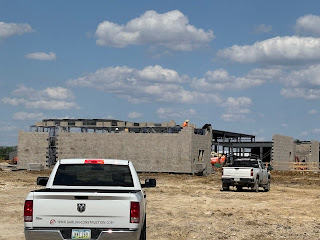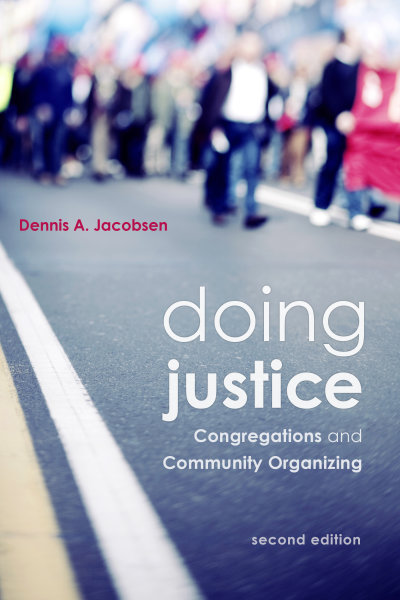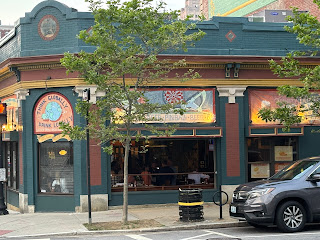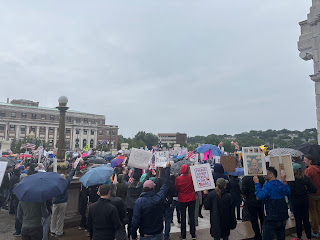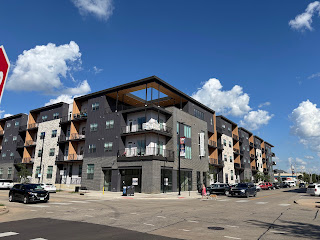 |
| Apartments across from Greene Square, part of a surge of building in the core of Cedar Rapids |
Ten years ago this month, I hosted two events featuring Charles Marohn, founder and CEO of Strong Towns: an evening public event at the Iowa City Public Library, and a meeting of the Corridor Metropolitan Planning Organization the next morning in Ely. Remarkably, I wrote nothing about those events and took no pictures; all I did was post a link to the video on Iowa City's website, which link has, alas, now expired. (A subsequent Iowa City appearance by Chuck, in 2019, can be found here:)
I did take pictures in July 2015, lots of them, of churches in the Oak Hill Jackson neighborhood. The idea was that there were a number of houses of worship remaining from the era when the core of Cedar Rapids was bustling and dense, and that when--as I anticipated--urbanism returned bustle and density to the city center, these religious institutions would be ready to support the new arrivals and be the basis for renewed community.
Since that post, three more churches have been started in Oak Hill Jackson, and I have acquired editions of Polk's Directory for 1953 and 1998 that show changes in the property uses as well as in the surrounding areas.
New Churches
 |
| Veritas is a non-denominational church that hosts a coffeehouse on weekdays |
Veritas Church, 509 3rd St SE
In 1953 this building was Nash Finch wholesale grocers (the folks who operated the Econo Foods and Sun Mart chains). There was a Sinclair station on the other side of 3rd. In 1998 there was no listing for the church's current address, while Cedar Valley Habitat for Humanity occupied the building across the street that is now their ReStore. The oldest Google Earth photo, from 2012, shows the Intermec company occupying this building.
Trinity Presbyterian Church, 1103 3rd St SE
This congregation was started in 2020, and is affiliated with the conservative Presbyterian Church of America. They hold services in the theater at CSPS Hall, a historic Czech and Slovak community center dating from the 1890s. In 1953, this block of 3rd Street had, besides CSPS, six single-family households, one duplex, and 11 businesses, as well as the Salvation Army at 1119-1123 (now Parlor City). In 1998, there were two households and five businesses sharing the block with CSPS.
Revolution Community Church, 1202 10th St SE
This congregation, along with the ROC (Recovering Our City) Center, is using the building that ten years ago was occupied by Oak Hill Jackson Community Church. The sign above the door actually says "Refuge City Church," which testifies to the versatility of the abbreviation "RCC." In 1953 this was St. George Syrian Orthodox Church, which built the church in 1914; they moved to Cottage Grove Avenue SE in 1992. In the 1998 Polk's Directory there was no listing on 10th Street SE between 12th and 15th Avenues.
Older White Denominations
This venerable church was built in 1869, and occupies the same block as the also-historic YWCA, opposite Greene Square Park. "First Pres" is the first of the oldline Third Avenue Churches; now, with the departure of First Christian Church and People's Church (Unitarian Universalist) in the 2010s, it is also the only mainline church on the southeast side below 10th Street.
St. Wenceslaus Catholic Church, 1224 5th St SE
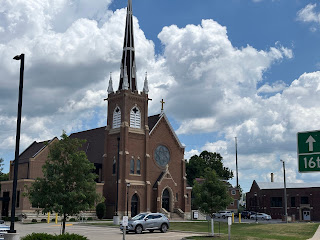 |
Built in 1904, this church long served the working class neighborhood around the Sinclair meatpacking plant. In 1953 just that block of 5th Street had 14 households containing 47 residents, as well as two vacant houses and the Sisters of Mercy at 1230 5th. In 1998, the block still had seven occupied residences, but all the older houses in the area were bought up and leveled after the 2008 flood.
Historically Black Congregations
New Jerusalem Church of God in Christ, 631 9th Av SE
This church was built by Hus Presbyterian Church in 1915; Hus moved to Schaeffer Drive SW in 1973, and then closed in 2021. The 9th Avenue block had seven single-family homes and four duplexes in 1953, with a total of 68 residents. By 1998, the New Jerusalem congregation was established in the building, and the block listed five single-family homes and two duplexes.
Historically Black Congregations (possibly shut)
Fellowship Missionary Baptist Church, 1030 7th St SE
This church was built in 1965, but it's not clear that it's still in operation. Their Facebook page last updated 2022, and they're no longer listed on American Baptist Churches website. The banner still appears on the building, and the lawn is cut, but a sign on the door says "Mask required to enter," which surely is a vestige of the coronavirus pandemic of 2020-21.
In 1953, this address was the home of John D. Malbrue, a factory worker for Collins Radio, and his family of five. The block had 13 homes for 45 people, as well as a grocery store at 1000 7th. In 1998, the block had three homes, the church, and a social service organization called Options; 1000 7th was vacant. (Today 1000 7th is the site of the charming Sacred Cow tavern.)
Southeast Church of Christ, 930 9th St SE
A handsome "Church of Christ" sign has been added to the exterior since 2015, but the charming garden I noticed is gone. Its web and Facebook links are to churches in Texas. In 1953, the building contained the grocery store of William W. Krejci; the block had 10 single-family homes and five duplexes, with a total population of 68. The 1998 Polk's Directory lists the Church of Christ, nine homes, and two "not verified." It's still a well-settled block.
Here in 1998, but no longer
Mt. Zion Missionary Baptist Church, 824 8th St SE
Mt. Zion moved to the edge of town after the 2008 flood, after nearly a century in the neighborhood. Its location is now part of a parking lot for the MedQuarter. Before the move, that block of 8th Street, which once was home to 56 people besides the church and a funeral home, was down to the church and one vacant property.
Church of Jesus Christ of the Apostolic, 916 10th St SE
In 1953 this address was the house owned by Mrs. Francis Leksa. It is now part of an apartment complex constructed post-flood.
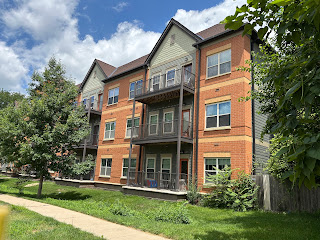 |
| Plenty of churches remain nearby: Harris Oak Hill Apartments |
Holy Ghost Missionary Baptist Church, 1003 6th St SE
There is no listing for this address in the 1953 Polk's Directory, but 1001 6th was the home and store of grocer Milo Grubhoffer. What was probably the church building was for some time post-flood used for storage by the nonprofit Feed Iowa First. Something new is being constructed in its place even as we speak.
 |
| Construction at former Holy Ghost site |
Ten years on, the church scene in Oak Hill Jackson is different, but similar. In the meantime, there's been a lot of building.
 |
| New Bo Lofts addition, across from St. Wenceslaus |
 |
| Loftus Lofts, in the heart of New Bohemia |
Will all this new construction be populated? Will the new residents find, or even look for, community in their neighborhood churches? Do the churches even want to play the role of community rebuilder, or are they focused on their present membership? To answer these questions, we would need data, which I famously don't have.
ORIGINAL POST (with more pictures): "CR Churches," 20 July 2015





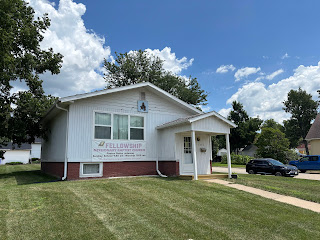




_(cropped).jpg/800px-Pete_Hegseth_(52941454126)_(cropped).jpg)













